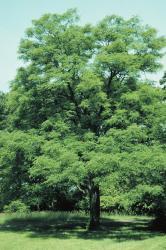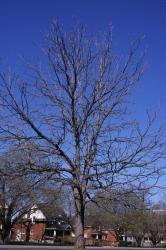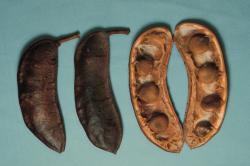| Gymnocladus dioica Kentucky Coffeetree
|
| Description | Kentucky coffeetree has rightfully earned increasing popularity in recent years for its success growing along sidewalks in downtown cores. This species adds an extra touch of grace with its uniquely textured foliage, interesting bark and coarse winter texture. |
| Usage | Shade tree, specimen, street tree. |
| Origin | Extreme southern Ontario, central and eastern USA |
| Hardiness zone | 4 |
| Size | 15-20m |
| Form/texture | Narrow, pyramidal or oval. "Bold textured in winter, changing when in leaf to a fine-medium effect" (Jacobson). "�coarse, but not offensively so, in winter" (Dirr 1998). Bark is "characteristically roughened with tortuous, recurved, scale-like ridges which are distinct even upon comparatively young branches" (Dirr 1998). |
| Growth rate | Slow to moderate, long lived. |
| Leaf | Large bi-pinnately compound leaves up to 1m long, showy yellow in fall. Leaflets rotate with the sun on bright summer days so that only the leaf margin is exposed to the hot sun. Leaflets drop in the fall before the leaf and leaflet stalks. |
| Flower | Greenish white, fragrant, May-June, dioecious; not showy. |
| Fruit | On female plants, a pod, 5-10 inches long, green ripening to brown, persistent "�only the great pods cling on, like open purses, their contents scattered in a spendthrift's gesture" (Peattie). "The seeds are great fun to throw and hit with a baseball bat" (Dirr 1998). "The appearance of the beans or seeds, rather than the taste, must have induced the pioneers to roast and brew them to make what can only by imagination and forbearance be called coffee" (Peattie). |
| Exposure/culture | Full sun only. All soil textures, wide range of soil pH. Tolerates occasionally wet to very dry soil. Tolerant to deicing salt (Beckerman et al and Morton). Nearly pest-free. |
| Comments | A native tree in Ontario, though somewhat rare. "To know her is to love her. A wonderful native species that tolerates the worst stresses nature and humanity can impose, yet it is nowhere very common in the landscape" (Dirr 1997). Named from the Greek, meaning naked branches which refers to the long dormant stage. A bare tree in May is often mistaken as dead. Kentucky coffeetree has earned increasing popularity in recent years for its graceful form, texture and success growing along sidewalks in downtown cores. It is durable and very tolerant of alkaline soils, which is an added benefit for many parts of southern Ontario. Kentucky coffeetree will send up suckers from the roots as it ages but this is not a problem in developed areas or lawns that are mown. Increasing popularity has also led to more interest in cultivar development. Use male cultivars to avoid fruit litter. |




Reference:
Beckerman, J. and B.R. Lerner. 2009. Salt Damage in Landscape Plants. Purdue Extension Publication ID-412-W. Purdue University. West LaFayette, IN.
Dirr, M. 1997. Dirr's Hardy Trees and Shrubs. Timber Press, Portland, OR. 493pp.
Dirr, M. 1998. Manual of Woody Landscape Plants. Stipes Publishing, Champaign, Illinois 1187pp.
Jacobson, A.L. 1996. North American Landscape Trees. Ten Speed Press, Berkely California. 722pp.
Peattie, D.C. 1964. A Natural History of Trees of Eastern and Central North America. 2nd ed. Bonanza Books. New York, NY. 606pp.